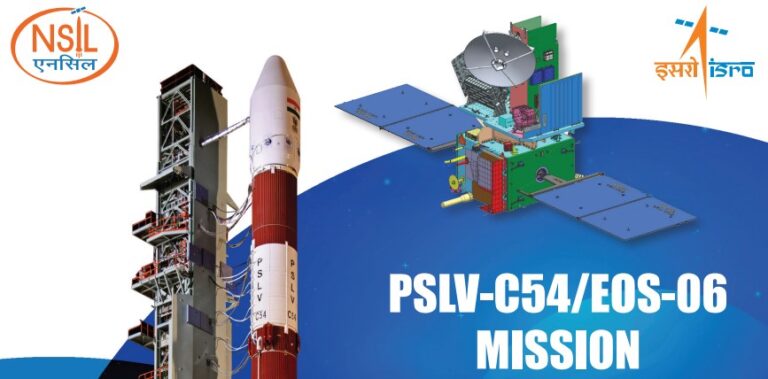EOS-06/PSLV-C54 Mission

The Prime Minister, Shri Narendra Modi has congratulated the Indian Space Research Organisation (ISRO) and NewSpace India Limited (NSIL) on the successful launch of the EOS-06/PSLV-C54 mission.
The third-generation Indian satellite for monitoring the oceans, formally named as Earth Observation Satellite-6 (EOS-6) was launched from its First Launch Pad (FLP) at Satish Dhawan Space Centre (SDSC), Sriharikota on 26 November 2022.
Launched by:
EOS-6 was launched by the Indian Space Research Organization (ISRO) in partnership with Ministry of Earth Sciences (MoES) among others.
- The satellite was launched aboard the proven launch vehicle PSLV (Polar Satellite Launch Vehicle) on its 56th flight (24th flight of the PSLV-XL version). The launch, designed as PSLV-C54, also accommodated other small satellites along with Oceansat-3.
EOS-06/PSLV-C54 Mission: Oceansat-3
» EOS-6 is the third-generation satellite in the Oceansat series. This is to provide continuity services of Oceansat-2 spacecraft with enhanced payload specifications as well as application areas.
- Oceansat-3 is expected to provide improved accuracy in wide range of operational and research applications including fishery resource management, ocean carbon uptake, harmful algal bloom alerts, and climate studies.
- The major operational user of this satellite would be Ministry of Earth Sciences (MoES) institutions viz Indian National Centre for Ocean Information Services (INCOIS), Hyderabad and National Centre for Medium Range Weather Forecasting (NCMRWF), Noida.
Key Points:
- The Oceansat-3 was placed in the polar orbit at the height of about 740 kilometers above sea level.
- While at ~1100 kilograms, it is only slightly heavier than Oceansat-1; for the first time in this series, it houses three ocean observing sensors viz Ocean Color Monitor (OCM-3), Sea Surface Temperature Monitor (SSTM), and Ku-Band scatterometer (SCAT-3).
- There is also an ARGOS payload. All these sensors have their own importance for India’s blue economy aspirations.
EOS-6 Payloads:
- Ocean Color Monitor (OCM-3)
- Sea Surface Temperature Monitor (SSTM)
- Ku-Band Scatterometer (SCAT-3)
- ARGOS
Ocean Color Monitor:
» The advance 13 channel OCM with 360 m spatial resolution and 1400 km swath will observe the day side of the earth every day and will provide crucial data on distribution of ocean algae which is the base of the food chain within marine ecosystem.
- The OCM-3 with high signal-to-noise ratio is expected to provide improved accuracy in daily monitoring of phytoplankton having wide range of operational and research applications including fishery resource management, ocean carbon uptake, harmful algal bloom alerts, and climate studies.
SSTM:
» The SSTM will provide ocean surface temperature which is a critical ocean parameter to provide various forecasts ranging from fish aggregation to cyclone genesis and movement.
- Temperature is a key parameter required to monitor health of the coral reefs, and if needed, to provide coral bleaching alerts.
Ku-Band Scatterometer (SCAT-3):
» The Ku-Band Pencil beam scatterometer onboard EOS-6 will provide high resolution wind vector (speed and direction) at the ocean surface, something which any seafarer would like to know of, whether its fishermen or shipping company.
- The data of temperature and wind is also very important for assimilation into ocean and weather models to improve their forecast accuracies.
ARGOS:
» ARGOS is a communication payload jointly developed with France and it is used for low-power (energy-efficient) communications including marine robotic floats (Argo floats), fish-tags, drifters, and distress alert devices useful for conducting effective search and rescue operations.
Other Points:
- The launch of Oceansat-3 is also significant since this is the first major ocean satellite launch coming from India since the initiation of the UN Decade of Ocean Science for Sustainable Development (UNDOSSD, 2021-2030).
- The ocean observing mission is a follow up to OceanSat-1 or IRS-P4 and OceanSat-2 launched in 1999 and 2009, respectively.
Other Satellites in PSLV-C54 Mission:
India-Bhutan SAT:
» The PSLV C54 carried the India-Bhutan SAT, along with India’s Earth Observation Satellite -06 and other satellites from the Satish Dhawan Space Centre from Sriharikota, Andhra Pradesh.
- The India-Bhutan SAT is jointly developed by India and Bhutan. The Prime Minister, Shri Narendra Modi commended Department of Information Technology & Telecom (DITT) Bhutan and ISRO on the successful launch of this jointly developed satellite.
Key Points:
- ISRO Nano Satellite-2 for Bhutan (INS-2B) spacecraft is configured with INS-2 Bus.
- INS-2B will have two payloads namely NanoMx and APRS-Digipeater.
- NanoMx is a multispectral optical imaging payload developed by Space Applications Centre (SAC). APRS-Digipeater payload is jointly developed by DITT Bhutan and URSC.
» The India-Bhutan SAT will provide high resolution images to Bhutan for their natural resources management. The satellite is expected to provide Bhutan with high resolution images for land-mapping and managing its natural resources, agriculture and forests.
» Bhutan’s first indigenous nano-satellite called Bhutan-1, built with Japan’s assistance was launched on a SpaceX rocket in 2018.
Anand:
» The Anand Nano satellite is technology demonstrator to demonstrate the capabilities and commercial applications of miniaturized earth-observation camera for earth observation using a microsatellite in Low Earth Orbit.
- This is a three-axis stabilized satellite consisting of a satbus, accommodating all subsystems like telemetry, tele-command, Electrical Power system, Attitude Determination and Control System (ADCS), on-board computers etc, and a payload unit.
Astrocast (4 NOS.)
» Astrocast, a 3U spacecraft is a technology demonstrator satellite for the Internet of Things (IoT) as the payload.
- There are 4 nos of Astrocast Satellites in this mission. These spacecraft are housed within an ISISpace QuadPack dispenser. The dispenser protects the satellite from contamination.
Thybolt (2 NOS.)
» The Thybolt is a 0.5U spacecraft bus that includes a communication payload to enable rapid technology demonstration and constellation development for multiple users.
- It also demonstrates Store-and-Forward functionality for authorized users in the amateur frequency band.
- The satellites shall be deployed by using Dhruva Space Orbital Deployer to perform the specific mission operations for a minimum lifetime of 1 year.
